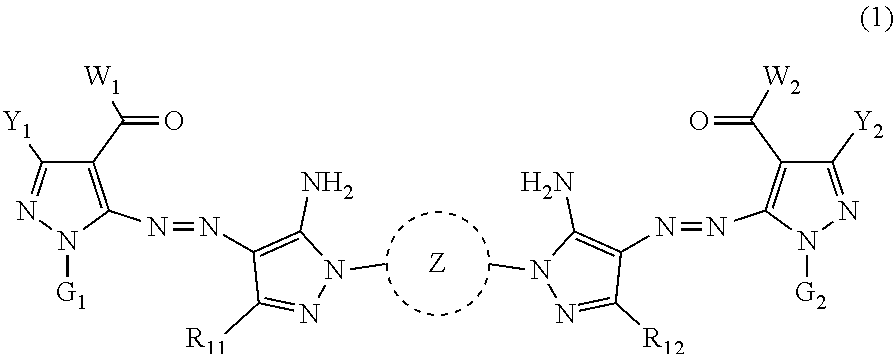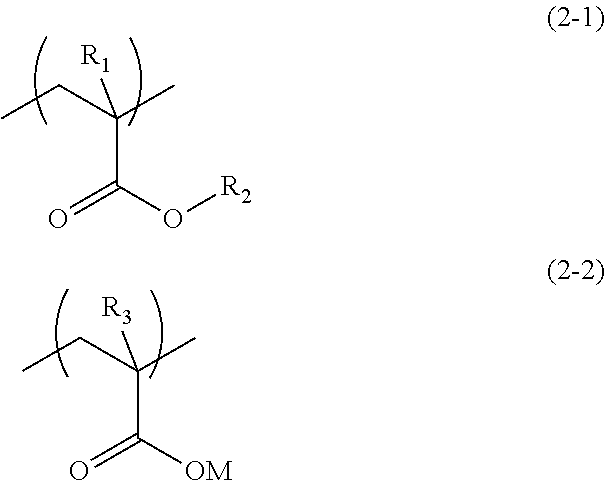Pigment dispersion liquid and inkjet ink
- Summary
- Abstract
- Description
- Claims
- Application Information
AI Technical Summary
Benefits of technology
Problems solved by technology
Method used
Image
Examples
synthesis example 1
[0219]6.1 g of PERBUTYL O (manufactured by NOF Corporation) was added to 186.0 g of dipropylene glycol (DPG), the mixture was stirred, and thus an initiator solution was produced.
[0220]Separately, 298.2 g of benzyl methacrylate, 61.9 g of methacrylic acid, and 11.9 g of butyl 3-mercaptopropionate as a chain transfer agent were added to 139.5 g of DPG, the mixture was stirred, and thus a monomer solution was produced.
[0221]241.5 g of DPG was introduced into a 2-L three-necked flask, and under a nitrogen stream, the internal temperature was raised to 85° C. Addition of the initiator solution and the monomer solution thereto was begun simultaneously, and the solutions were added over 5 hours and 4 hours, respectively. After completion of the addition of the initiator solution, the mixture was stirred for 2 hours at 85° C. and then was cooled to 70° C. 64.5 g of a 50 mass % aqueous solution of potassium hydroxide, 43.8 g of water, and 27.4 g of DPG were added to the mixture, and the res...
synthesis example 2
[0225]2.7 g of V-601 (manufactured by Wako Pure Chemical Industries, Ltd.) was added to 77.2 g of triethylene glycol (TEG), the mixture was stirred to completely dissolve, and thus an initiator solution was produced.
[0226]Separately, 123.7 g of benzyl methacrylate, 25.7 g of methacrylic acid, and 4.9 g of butyl 3-mercaptopropionate as a chain transfer agent were added to 57.9 g of TEG, the mixture was stirred, and thus a monomer solution was produced.
[0227]100.3 g of TEG was introduced into a 1-L three-necked flask, and under a nitrogen stream, the internal temperature was raised to 80° C. Addition of the initiator solution and the monomer solution thereto was begun simultaneously, and the solutions were added over 5 hours and 4 hours, respectively. After completion of the addition of the initiator solution, the mixture was stirred for 2 hours at 85° C. and then was cooled to 70° C. 26.8 g of a 50 mass % aqueous solution of potassium hydroxide, 18.2 g of water, and 11.3 g of TEG wer...
synthesis example 3
[0230]9.0 g of PERBUTYL O was added to 276.8 g of 1,2-hexanediol (1,2-HDO), the mixture was stirred, and thus an initiator solution was produced. Separately, 438.0 g of benzyl methacrylate, 92.0 g of methacrylic acid, and 23.5 g of 2-ethylhexyl 3-mercaptopropionate were added to 207.6 g of 1,2-HDO, the mixture was stirred, and thus a monomer solution was produced.
[0231]359.5 g of 1,2-HDO was introduced into a 3-L three-necked flask, and under a nitrogen stream, the internal temperature was raised to 85° C. Addition of the initiator solution and the monomer solution thereto was initiated simultaneously and was continued for 5 hours and 4 hours, respectively. After completion of the addition of the initiator solution, the mixture was stirred for 2 hours at 85° C. and then was cooled to 70° C. 96.0 g of a 50 mass % aqueous solution of potassium hydroxide, 65.2 g of water, and 40.7 g of 1,2-HDO were added to the mixture, and the resulting mixture was stirred for 2 hours at 70° C. 1,367 ...
PUM
| Property | Measurement | Unit |
|---|---|---|
| Molality | aaaaa | aaaaa |
| Molality | aaaaa | aaaaa |
| Molality | aaaaa | aaaaa |
Abstract
Description
Claims
Application Information
 Login to View More
Login to View More - R&D
- Intellectual Property
- Life Sciences
- Materials
- Tech Scout
- Unparalleled Data Quality
- Higher Quality Content
- 60% Fewer Hallucinations
Browse by: Latest US Patents, China's latest patents, Technical Efficacy Thesaurus, Application Domain, Technology Topic, Popular Technical Reports.
© 2025 PatSnap. All rights reserved.Legal|Privacy policy|Modern Slavery Act Transparency Statement|Sitemap|About US| Contact US: help@patsnap.com



